
 |
Tasmanian Dragon Search
Project:
Bioregional Summary of
Sighting Data
August 1997 - April 2002
Compiled by Craig Woodfield for the Tasmanian Marine Naturalists Association Inc.
Section A: Background
1. Seadragons
Seadragons are found only in southern Australian waters. Along with
seahorses, pipehorses and pipefish these spectacular fish belong to the
Family Syngnathidae. Syngnathids are long, slender fish with bony plates
surrounding their bodies. The Latin name 'syngnathid' refers to their jaws,
which are united into a 'tube-snouted' mouth. The two species of seadragons,
the Leafy Seadragon (Phycodurus eques) and the Weedy Seadragon (Phyllopteryx
taeniolatus), both have many leaf-like appendages on their heads and bodies.
The Weedy Seadragon is the only seadragon species confirmed to be found
in Tasmania.
Weedy Seadragons grow to about 46 cm in length. Adults are usually reddish with yellow spots and purple-blue bars. Small leaf-like appendages occur singularly or in pairs along the body. A few short spines also occur along the body. It is quite easy to determine the gender of a weedy seadragon. A male weedy has a shallow body width and is generally darker in colour than the female. Weedies have been recorded from Geraldton in Western Australia along the southern Australian coastline - including Tasmania - to Port Stephens in New South Wales.
2. Seadragon habitat and biology
Seadragons resemble swaying seaweed, which can make them difficult
to find in their natural habitats. They are slow moving and therefore rely
heavily on camouflage for their survival. Their bright colours are revealed
in sun dappled waters or under bright camera lights. Both species of seadragon
inhabit rocky reefs, seaweed beds, seagrass meadows and structures colonised
by seaweed. In the wild they live individually or in pairs are more often
seen in shallow coastal waters. They feed by sucking plankton, larval fishes
and small shrimp-like crustaceans, called mysids, into their small mouths.
This is done by quickly expanding a joint on the lower part of their snout,
causing a suction force that draws the food in.
As spring approaches, male and female seadragons pair. The female develops around 300 orange eggs in her lower abdominal cavity. The lower half of the tail on the male begins to form fine blood vessels near the surface, swells and looks wrinkled. He then develops small pits or 'egg cups' on the tail and the eggs are transferred from the female and fertilised.
The male carries the eggs for an incubation period of about 4 weeks. The young seadragons hatch over several days. This staggered hatching is to aid dispersal and avoid competition for food amongst the young. At birth, seadragons are around 20mm long and are often differently coloured to the adults. The young are preyed upon by fish, crustaceans and sea anemones and live in different places to the adult seadragons. The young dragons are fast growing, reaching 20cm after one year and a mature length after about two years. It is not known how long wild seadragons live. In captivity it is thought that they can live for about 5 to 7 years.
3. Threats to Seadragons and other Syngnathids
There is increasing concern about the future of seadragons and other
syngnathids in Australian waters. Seahorses, seadragons, and in particular,
pipefish, are threatened globally by habitat destruction. An estimated
20 million seahorses (but not seadragons) are taken each year for traditional
Asian medicines. The international trade in seahorses and pipefish involves
more than 20 countries and is growing. Fortunately seadragons currently
are not used for the medicine trade, however they may be targeted in the
aquarium fish trade. Keeping live seadragons is extremely difficult and
collectors often target males with eggs, hatching out and selling the young.
Removing these brooding animals from the wild populations may impact on
local populations of seadragons. To date, no successful, closed cycle,
captive-breeding program has occurred (ie getting a generation of captive-raised
seadragons to breed). Economically and environmentally, it makes sense
to limit collection and export of this species until we know more about
them. Seadragons have a specific level of protection under fisheries legislation
federally and in most Australian states where they occur, such that it
is illegal to take or export them without a permit. In Tasmania, it is
illegal to collect or intentionally harm any Syngnathid species without
a permit.
4. Why survey for seadragons?
Most of the research on marine species in Australia is on commercial
fish species and little is known about even the most common non-commercial
species. Recreational divers represent a large, virtually untapped repository
of information about the marine environment. By making divers familiar
with recording observations, Dragon Search encourages them to be pioneering
researchers.
There are usually limited resources for fisheries managers to investigate the conservation and management of fish that are not directly targeted by 'traditional' recreational or commercial fishing. With this in mind the Marine and Coastal Community Network (SA), the Threatened Species Network (SA) and the Marine Life Society of South Australia undertook to develop a database of leafy and weedy seadragon sightings in South Australia in 1995. Variations on the Dragon Search project were subsequently developed in Western Australia, Victoria, New South Wales and Tasmania. Seadragons are potentially a "flagship species" for marine conservation in southern waters. They are popular species that can serve as a rallying point for major conservation initiatives. Long-term monitoring of seadragon populations could also be useful as indicators of changes in water quality, especially in relation to catchment events, if there proved to be a link between seadragons and water quality.
Fish such as the seadragon also highlight the high degree of uniqueness or endemism of species that exists in southern temperate waters. For example, as well as the many unique fish and invertebrates, there are twice as many species of seaweeds alone in southern waters than on the Great Barrier Reef. Australians are not generally aware of the immense marine biodiversity they have off their southern coast and the spectacular and unique environments that exist there.
Increased awareness and involvement of local communities may help prevent poaching of seadragons and encourage protection of both the species and its habitat. Responses to the project have already reflected this, with people from around the country contacting the project coordinators to express concern over potential threats.
5. Dragon Search
The principle aims of Dragon Search are:
- to increase awareness, understanding and appreciation of syngnathid
fish and the need for their protection and conservation;
- to actively promote habitat protection and species conservation through
the abatement of threats affecting the marine environment and syngnathid
fish;
- to establish a pilot program of community-based monitoring and a
database that can be used as an aid to increase knowledge and define key
habitat areas for syngnathids; and
- to instil community pride and custodianships for our unique marine
environment and wildlife.
Dragon Search provides valuable information on one of our unique, non-commercial fish species that may help to identify potential sites for marine reserves, not just for seadragons, but to conserve a comprehensive and representative range of our unique marine life and habitats. No-take marine reserves provide refuges for fish and therefore provide benefits to the local marine environment and in the long term the fishing industry. Dragon Search also supports the principles of ecologically sustainable development.
6. The Dragon Search database
Information from the sighting sheets is entered into a database. Our
database containing the raw data is confidential and no site-specific information
is passed on. Analysis of the Dragon Search databases from each State are
available from the Dragon Search website. These reports will based on a
broad bioregional scale as defined in the Interim Marine & Coastal
Regionalisation of Australia. Dragon Search has actively encouraged syngnathid
protection legislation nationally and at a state level. With the on-going
success of this community-based survey program we hope to encourage the
development of databases for other endemic and protected fish and invertebrate
species.
7. Dragon Search in Tasmania
The Tasmanian Dragon Search program has been run by the Tasmanian Marine
Naturalists Association since August 1997. Funding for Dragon Search in
Tasmania has been provided by Natural Heritage Trust grants through the
Fishcare, Coastcare, Coast and Cleans Seas and the Fisheries Action Plan
programs. During this four and a half year period, Dragon Search Tasmania
liased extensively with recreational divers, dive clubs and dive shops
around the state. A total of 248 sighting forms were collected in this
time. All data has been entered into an Access database. This report represents
the summary of this data, which will be distributed to all project participants
and made available from the Dragon Search website.
Section 2: Results
1. Distribution
There are seven marine bioregions in Tasmanian waters: Boags, Bruny, Davey, Flinders, Franklin, Freycinet and Otway. See Appendix 1 for the location of these bioregions. During the period that Dragon Search was run in Tasmania, seadragons were sighted in six of these bioregions. All but three of these sightings were of weedy seadragons. Two reputable sightings reported leafy seadragons on the north and north-east coast while one unreliable sighting was in the southeast. No confirmation of these reports has been obtained, and it is generally accepted that this species does not occur in Tasmanian waters. Therefore, these sightings have been incorporated into the general data along with weedy seadragons.
A total of 472 seadragons were sighted, in 248 separate sightings. The vast majority of these were in the Bruny bioregion (72.9% of seadragons sighted, 71.2% of sightings), with the Boags, Flinders and Freycinet bioregions accounting for the majority of the remainder. Only two sightings occurred in both the Otway and Franklin bioregions, whilst no sightings were made in the Davey bioregion.
Table 1: Breakdown of Seadragon sighted
| Bioregion | Number of seadragons sighted | % of total seadragons sighted | Number of sightings | % of total sightings |
| Boags | 23 | 4.9 | 20 | 8.1 |
| Bruny | 342 | 72.6 | 175 | 70.6 |
| Davey | 0 | 0 | 0 | 0 |
| Flinders | 46 | 9.7 | 14 | 5.6 |
| Franklin | 4 | 0.8 | 2 | 0.8 |
| Freycinet | 54 | 11.4 | 35 | 14.1 |
| Otway | 3 | 0.6 | 2 | 0.8 |
| Total | 472 | 100 | 248 | 100 |
The prevalence of sightings in the Bruny bioregion is partly because a project officer was based in this region for the first two years of the project, and partly because this area is the focus of the Tasmanian diving industry.
The breakdown of sighting method is shown in table 2.
Table 2: Type of sighting
| Scuba diving (day) | 168 |
| Scuba diving (night) | 4 |
| Snorkelling | 2 |
| Beachcombing | 72 |
| Other | 1 |
The seasonality of all sightings in all regions is shown in Figure 1.
The number of seadragons sighted and sightings are suprisingly uniform
throughout the year. At least 20 seadragons have been sighted every month
except for April, so the sightings do not seem to be biased towards any
particular season.
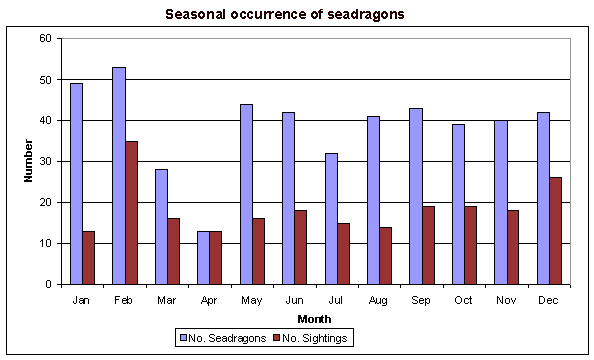
Figure 1: Seasonal occurrence of seadragons
The sex of the seadragon sighted was not always stated, and the difference between the sexes is not obvious, especially when seadragons are seen in isolation. Overall, numbers of male and females reported were roughly equal.
2. Breeding
Of the 22 sightings of brooding males (28 individual seadragons), 14 (19 seadragons) were in the Bruny bioregion, 7 (8 seadragons) in the Freycinet bioregion and 1 (1 seadragon) in the Otway bioregion. Brooding males were only sighted in summer, spring and early autumn, indicating that the breeding season starts in spring and peaks in summer (Figure 2). This differs from NSW, where brooding males are sighted all year around.
It has long been accepted that breeding in seadragons is triggered by water temperature increases. There were 17 sightings of brooding males where water temperature was recorded. The lowest recorded was 12 degrees, and the highest 19 degrees, and the average 14.2 degrees.
The definition of ‘juvenile’ used for Dragon Search is anything smaller
than 20cm length, and thus incorporates hatchlings to sub-adult seadragons.
There were 32 sightings of juveniles (82 seadragons). 18 of these sightings
also included adult seadragons. Sightings of juveniles shows peaks in June,
August, September and November (Figure 3). The low numbers of juveniles
sighted in March and April also correspond with low numbers of seadragons
sightings in general, but the low number of juvenile sightings in October
and December is not as easy to explain. The absence of a single peak suggests
that juveniles may take more than one year to reach adult size, and the
peaks in late winter/spring could be artefacts or may be different size/age
cohorts. Recording the size of juveniles sighted would give more precise
information on their times of hatching and development. It is worth noting
that very small and hatchling seadragons are almost impossible to see without
detailed searching and/or through chance.
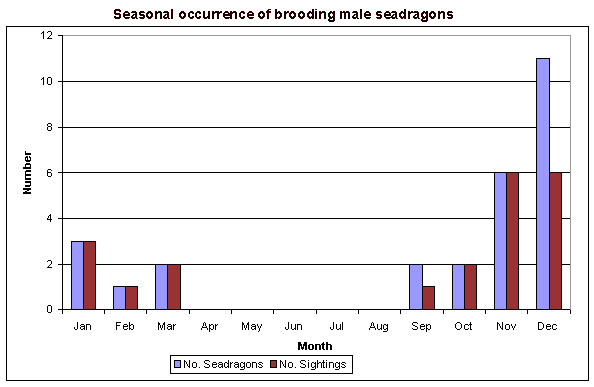
Figure 2: Seasonal occurrence of brooding male seadragons
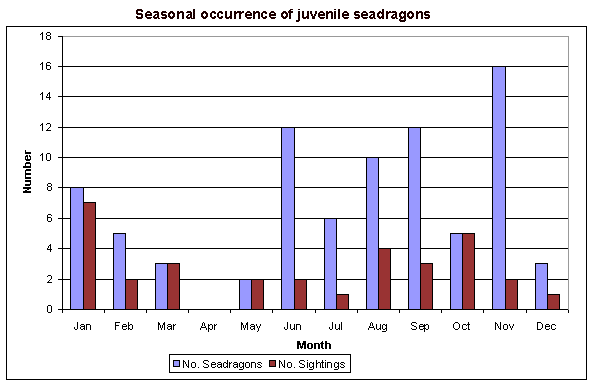
Figure 3: Seasonal occurrence of juvenile seadragons
3. Habitat
The majority of seadragons (58%) were sighted on reefs or in seaweed,
including giant kelp (Macrocyctis sp.) (Figure 4). Many of these occurred
on the reef edge where there is a rock shelf bordering sand. The next most
frequent habitat (13%) was sand. This analysis of the major habitats is
not biased by the frequency or seasonality of surveys. However, it
could be influenced by the choice of dive sites, since divers most frequently
swim over reef habitats. The depth of the most frequent sightings (3 –
6 m) corroborates that reef and seaweed are favoured habitats because most
seaweed grows at these depths. Generally giant kelp is the major seaweed
that grows at depths of 15 - 20 m, where the other sightings occurred.
More information on habitat could be collected by recording the dominant
species of seaweeds at the different depths when seadragons are sighted.
This would also give information on degree of exposure of seadragon habitat
to wave action since different seaweed species tend to be associated with
different degrees of exposure.
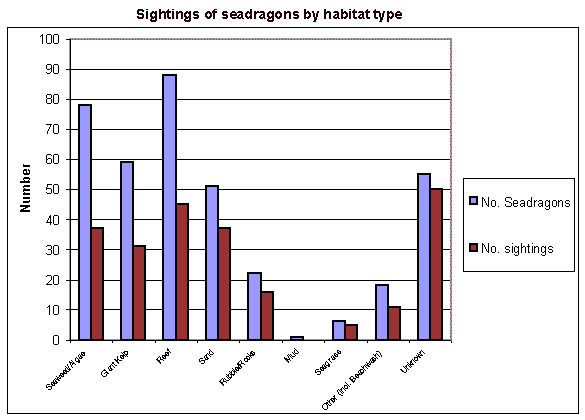
Figure 4: Sightings of seadragons by habitat type
4. Depth
The depth at which seadragons were sighted by divers or snorkellers
is shown in Figure 5. The largest number of seadragons were sighted in
water of less than 7 metres depth, with depths of 12 and 15 metres also
recording large numbers of actual seadragons sighted (inflated somewhat
by a few sightings of 10 or more fish at these depths). Actual sightings
decrease more or less steadily from a peak at 4 metres depth. The deepest
recorded seadragon, at 37 metres, was recorded on a wreck dive on the Tasman
Peninsula.
Average sighting depth overall was 9.3 metres. Average sighting depth
compared with habitat type was very uniform, ranging from 7.8 to 13.7 metres.
This data is heavily influenced by the preferred diving depth of most recreational
scuba divers, usually 15 metres or less.
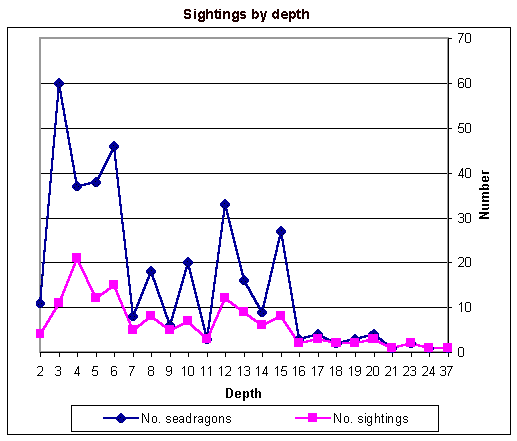
Figure 5: Sightings by depth
5. Peak populations
There were 89 sightings of two or more seadragons (any combination of adults or juveniles). A total of 21 of these sightings were of five or more seadragons. The majority of these were in the Bruny bioregion, at just three locations.
Table 3: Sightings of groups of five or more seadragons
| Location | Bioregion | No. of Sightings | Seadragons sighted (adults/juveniles) |
| Whitemark | Flinders | 1 | 14/0 |
| Lady Barron | Flinders | 2 | 6/0, 0/8 |
| Mirramar Park | Bruny | 8 | 13/3, 9/0, 12/0, 7/3, 6/1, 5/0, 4/1, 4/1 |
| Kingston | Bruny | 5 | 13/6, 10/10, 0/7, 3/2, 0/6 |
| Waterfall Bay | Bruny | 3 | 9/1, 5/0, 5/0 |
| Bicheno | Freycinet | 2 | 7/1, 3/10 |
The sighting of 14 seadragons at Whitemark was a beachcombing sighting over a four week period. The remainder are scuba diving sightings. Two of the sightings at Mirramar Park included multiple brooding males (four and three). Only three sightings of multiple brooding males were recorded throughout the survey.
6. Threats
The threats identified are summarised in below. Netting was the most frequent threat, which threatens most population sites, particularly on the Tasman Peninsula. A storm water outlet threatens one important population in the Derwent. Recreational fishing and collecting by line, snorkel and scuba threatens other populations in the Derwent. The site where the gas pipeline and power cable cross the north coast of Tasmania may threaten a population near Georgetown. Illegal collection of seadragons for private aquaria is considered to be a potential threat wherever seadragons are found.
Table 4: Threats to seadragons
| Threat type | Number of records |
| Netting | 13 |
| Craypots | 3 |
| Stormwater | 2 |
| Gas pipeline/Power cable | 2 |
| Discarded fishing line | 1 |
| Dumping of rubbish | 1 |
7. Limitations of data
Data obtained by voluntary surveys, such as used by Dragon Search, has its limitations. The numbers of surveys are strongly influenced by the frequency of visits to particular areas, so that a few seadragons living near popular dive sights will be reported frequently. Thus, location data needs to be interpreted with caution. However, total numbers sighted on any one occasion can give a truer indication of the population at a particular site. Seasonal data can also be biased because more people dive and beachcomb during the warmer months.
The surveys do not include an estimate of area covered so we cannot estimate population densities at those locations. However, the majority of seadragons are sighted singly or in pairs. The exceptions are during mating aggregations or when very young juveniles from the same brood are clustered. Thus, the multiple sightings have mostly occurred during a dive that passed through a series of seadragon territories along the shoreline, each inhabited by one pair. More detailed records are needed to estimate the average size of the territory of a seadragon/pair.
8. Conclusion and recommendations
Dragon Search has dramatically increased the amount of information that we have about Weedy Seadragon distribution and biology in Tasmania. Much work remains to be done, however. The Tasmanian Marine Naturalists make the following recommendations:
- The three areas within the Bruny bioregion where multiple sightings
of five or more seadragons occurred (Mirramar Park, Kingston Beach and
Waterfall Bay) should be considered as no-take marine protected areas to
protect the resident seadragon colonies.
- Surveys of the Davey bioregion, including interviewing of commercial
fishers, should be conducted to determine whether seadragons are present
in this area.
- More detailed measurements and observations of juvenile seadragons be done, to allow monitoring of different cohorts
- Monitoring of specific populations occur to determine site specificity and recruitment.
In June 2002 the Tasmanian Marine Naturalists will begin detailed video
mapping of seadragon habitat in several locations around Tasmania to further
increase our knowledge of these beautiful, enigmatic creatures.
Section 3: Further Information
Dragon Search
www.dragonsearch.asn.au
Tasmanian Marine Naturalists Association Inc.
www.tased.edu.au/tasonline/tasmarine
The Tasmanian Marine Naturalists Association Inc. is a community group comprising people with wide range of expertise and interests, ranging from amateur to professional, all with a common interest in the coastal and marine environment. The Association meets on the second Wednesday of each month in the Federation Room, Black Buffalo Hotel, corner of Letitia and Federal Streets, North Hobart. An invited speaker addresses the meeting at 7:30 pm, which is followed by the General Meeting. Members and friends are encouraged to meet at 6pm and socialise over a meal before the meeting. An outing is also scheduled each month, usually a shore walk exploring the rocky shore or a beach during a low tide but occasionally dives or other excursions are organised to learn about some aspect of marine life. The TMNA was founded in July 1995. It is a member of the Tasmanian Federation of Field Naturalists Associations and also of the Tasmanian Federation of Landcare Association as a Coastcare group. Membership of the TMNA starts at $20 per year.
Objectives
- To promote awareness of Tasmania's marine environment and to encourage
further understanding and research into the marine ecology of southern
Australia,
- educate its members and the general public,
- develop the role of the community in monitoring changes to the marine
environment,
- undertake field work,
- facilitate the transfer of information between members and other
organisations, and
- provide a social network for people who have an interest in the marine
environment.
Contacts for more information:
President: Dr Jane Elek
Phone: +61 3 6229 8264 (h) +61 3 6233 8220 (w)
Email: [email protected]
Secretary: Jo Carswell
Phone/Fax: +61 3 6265 5724 (h)
© Copyright Tasmanian Marine Naturalists Association Inc. 2002